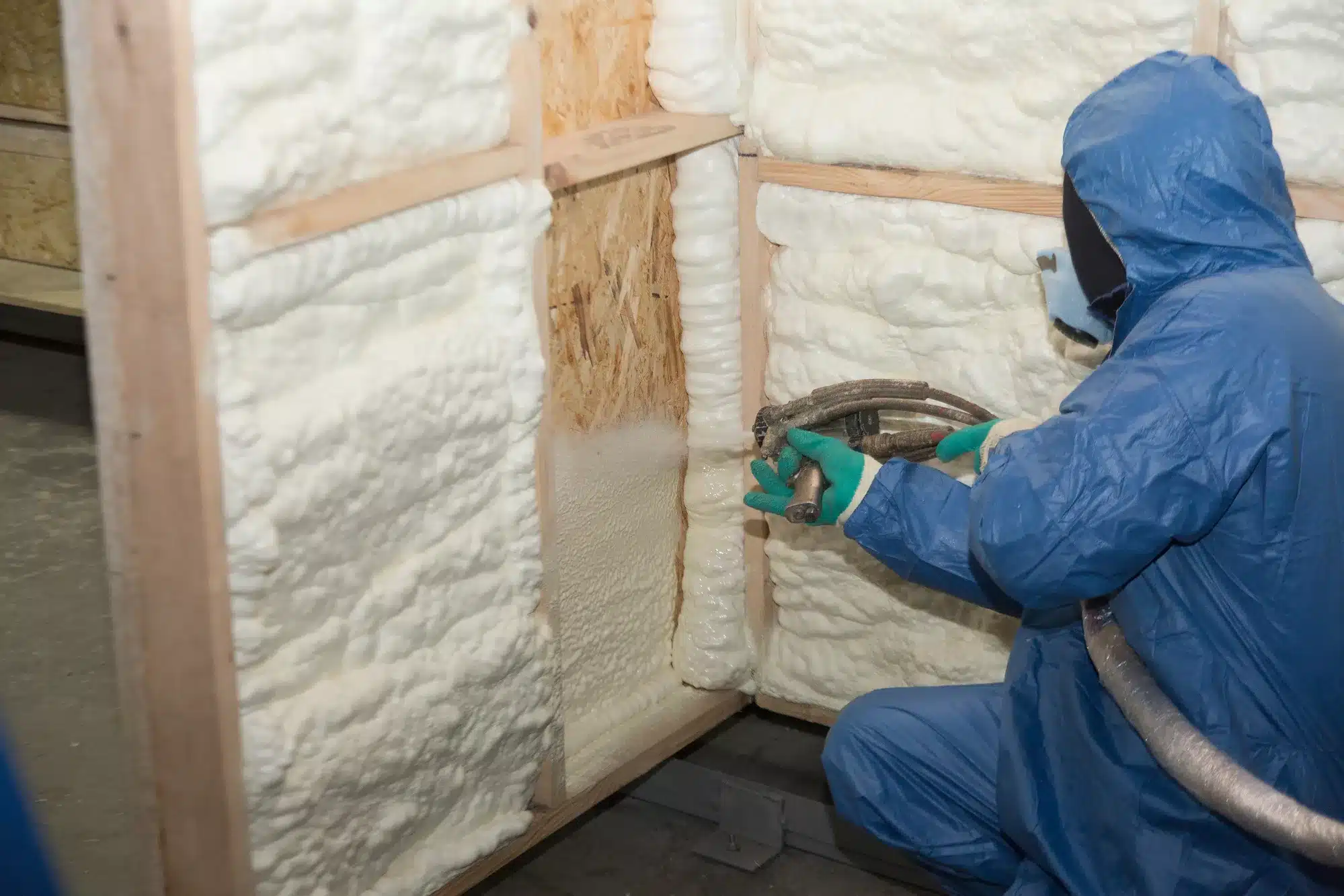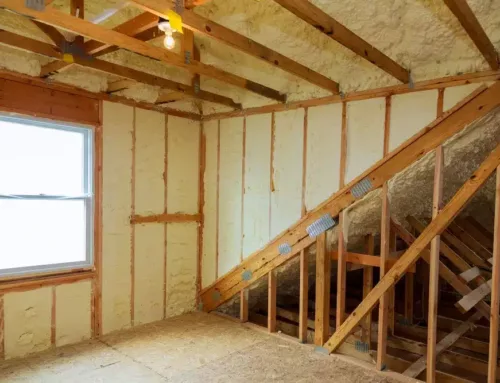Ever walked into a house on a scorching summer day and felt an instant, blissful chill? That’s insulation at work. And it’s not just any kind of insulation; we’re talking about spray foam insulation.
Imagine this: It’s like your home wearing a high-performance thermal vest that keeps the heat out in summer and locks it in during winter. The hero behind this magic is spray foam insulation. Spray foam insulation has several benefits that other types of insulation do not: Higher r-value and air sealing (to name a few).
The differences listed above in insulation could be the difference between enjoying comfort all year round or struggling with high energy bills.
Intrigued yet? This post will take you on an exciting journey exploring R-values, comparing open-cell and closed-cell spray foams, how they work their magic slowing down heat flow, and much more! Are you ready to dive into some cool insights? Let’s get started!
Understanding R-Values in Spray Foam Insulation
Spray foam insulation’s R-value is a measure of how well it resists conductive heat flow. In simpler terms, the higher this number, the better its insulating abilities. So if you’re aiming to slow down heat flows and cut energy costs, picking an insulation with a high R-value is key.
You might be wondering what makes spray foam so special? It’s all about understanding R-values. This type of insulation boasts one of the highest R-values per inch among popular materials – quite impressive.
In particular, open-cell and closed-cell are two types of spray foams that people often choose between when insulating their homes or buildings. Each has unique properties contributing to different R-values: Open cell typically offers around R-3.8 per inch, while closed cell delivers approximately R-7 per inch.
This makes both options viable for varying climates and project needs.
Types of Spray Foam Insulation and Their R-Values
Spray foam insulation comes in two forms: open-cell and closed-cell. Both types have different densities, benefits, and corresponding R-values.
Open-Cell Spray Foam Insulation
This type has a lower density which leads to its sponge-like structure. It’s an excellent sound absorber due to this unique property.
The R-value of open-cell spray foam is about R-3.8 per inch, making it suitable for interior applications where space isn’t much of a concern but noise reduction is desired.
Closed-Cell Spray Foam Insulation
Closed-cell spray foam has a denser composition with smaller cells that are tightly packed together filled with gas to help the foam expand providing greater insulating properties.
The high density gives closed cell an impressive R-value of 7 per inch, twice as efficient as its open-celled counterpart. This makes it ideal for spaces requiring maximum thermal resistance in minimal thicknesses such as exterior walls or crawlspaces.
How Does Spray Foam Insulation Work?
Spray foam insulation is a revolutionary advancement in the world of insulation. Its working principle involves slowing down heat flow and acting as an air barrier or vapor retarder, depending on its type.
The magic starts when two materials mix together during application. This chemical reaction causes it to expand and fill gaps, providing a continuous layer of insulation that helps keep your home cozy.
Closed-cell spray foam, thanks to its higher density, doubles up as both an air and vapor barrier – something not many insulations can brag about. But hold your horses; this doesn’t mean open-cell spray foam takes the backseat. It still shines by requiring only an additional vapor barrier.
Click to Tweet
Comparing Spray Foam Insulation to Other Insulation Types
When it comes to insulation, spray foam stands out for its high R-value. For instance, spray foam insulation, compared with fiberglass insulation, has a consistently higher R-value per inch.
The density of the foam affects its R-value significantly. Open-cell spray foam and closed-cell spray foams differ greatly when we consider their densities and respective R-values.
Fiberglass vs Spray Foam:
- Spray foam insulations offer an impressive range from about 3.8 per inch (open cell) up to 7 per inch (closed cell).
- In contrast, traditional fiberglass batts typically have an R-value between 2.9 and 3.8 per inch.
Factors Affecting the R-Value of Spray Foam Insulation
Spray foam insulation is not a uniform solution when it comes to its effectiveness. The R-value can change based on various factors like type, density, and thickness.
Type: Whether you use open-cell or closed-cell spray foam makes a big difference. Closed-cell has an impressive R-value of 7 per inch, while open cell trails behind with 3.8 per inch.
Density: Higher density means better insulation but also more cost. It’s a balancing act between performance and budget.
Thickness: Simply put, thicker application equals higher R-values as long as proper installation techniques are used.
The Impact of Temperature Differences
A lesser-known factor is the temperature delta – how much warmer or colder it is outside compared to inside your home can affect your choice between open-cell and closed-cell spray foams.
Benefits and Applications of Spray Foam Insulation
Spray foam insulation, whether open-cell or closed-cell, boasts a superior R-value. This high thermal resistance means more energy savings for you.
Discover the transformative advantages of spray foam insulation in our latest blog post. Offering unparalleled sealing properties, thermal efficiency, and soundproofing benefits, spray foam insulation ensures optimal comfort and energy savings while safeguarding indoor air quality. Its durability and environmental sustainability make it a wise investment for both residential and commercial properties, providing long-lasting performance and reducing the carbon footprint of buildings. Visit our blog today to unlock the full potential of spray foam insulation for your space.
Acoustic Benefits of Open-Cell Spray Foam
If noise reduction is what you’re after, open-cell spray foam has got your back. It offers improved acoustics compared to its closed-cell counterpart due to its lower-density structure which helps dampen sound transmission. But that’s not all it does.
Use of Closed-Cell Spray Foam for Exterior Insulation
Closed-cell spray foam acts like an unvented attic superhero when used as exterior insulation. With consistently higher R-values than other insulations, it makes sure your home stays cozy during those harsh Kansas winters and cool in scorching summers.
Click to Tweet
FAQs in Relation to What R Value is Spray Foam Insulation
What R-value is 2 inches of spray foam?
For closed-cell spray foam, the R-value for 2 inches thick would be around R-14. Open-cell would be about half that.
What is the R-value of spray foam in a 2×4 wall?
A typical 2×4 wall cavity filled with closed-cell spray foam will yield an approximate R-24 value, while open cell provides close to an R-13.
What is the highest R-value spray foam can have?
Closed-cell polyurethane has one of the highest possible ratings for any insulation material at approximately R-7 per inch thickness.
Conclusion
Understanding what R-value is in spray foam insulation isn’t just interesting—it’s essential for creating an energy-efficient home. You’ve ascertained that a higher R-value translates to insulation which is more proficient at impeding the transmission of heat.
You’ve discovered two types of spray foam: open-cell and closed-cell. Open-cell offers great acoustics with an R-value of around 3.8 per inch, while closed-cell provides a superior barrier against moisture and boasts an impressive R-value of approximately 7 per inch.
Remember, when it comes to comparing different types of insulation, spray foam often leads with its consistently high r-values—especially when density is factored in.
The key takeaway? Whether you’re building a new home or retrofitting your current one, understanding what r-value is spray foam insulation can help ensure comfort year-round and keep those energy bills under control!
Want to learn more about the advantages of Spray Foam? Contact our Spray Foam Insulation Experts today!




